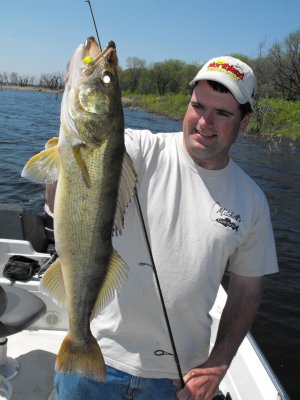
The author, Jason Mitchell catches numerous walleyes each season by long-lining lightweight jigs and split shot rigs a considerable distance behind the boat.
Over the years, an incredibly effective tactic for us is to long line a light jig or split shot rig through shallow water. In states where we could use two rods in particular, we often used the long line rig on the extra rod in the rod holder. There are probably several reasons why this setup works so well at times but I can attest to the fact that I have been outfished several times by the rod holder.
Back in the day, we used to pour our own jigs for this technique as you often wanted a light jig, say an eighth of an ounce or less but many of the smaller jigs had smaller hooks basically for crappie fishing. The smaller hooks just had a lower hooking percentage when combined with a larger minnow or half a crawler and they bent out more with heavy fish and soft lip tissue. We poured our own jigs and used wider gap and larger hooks but last year, Northland Tackle introduced a 1/32nd ounce Fireball Jig that is the perfect little jig for this described presentation. Most of the time, we like to use 1/32nd ounce or 1/16th ounce jigs but will use jigs as heavy as 1/8th ounce if the wind is pushing us along faster.
The amount of line out depended on boat speed and depth but typically, we are using this method in ten feet of water or less. Typically as well, we are moving somewhat slowly…. Say less than a mile an hour but still using an electric trolling motor or drifting through an area. We are not sitting still trying to keep the presentation vertical over the fish. This is a technique where you slowly move through an area and the line is very horizontal. Because the jigs are so small, you have to let out a considerable amount of line. The jig just kind of drags out there in no man’s land. Usually just because of the lift produced by the minnow, the jig never really does touch the bottom but rather just drifts through the water column.
I think the reasons why this rig can be so effective vary but one factor might be the fact that since the jig never touches or drags the bottom, it never gets fouled up with algae or wire grass. The jig is always clean and another reason is that fish often rise and hold higher in the water column particularly during the spring when the sun comes out. In clear water with decent visibility, fish that are on the bottom also has no problems gunning down a minnow that is two or three feet above them as well.
Finally, there must be something subtle about the presentation itself that seems to tweak walleyes. This tiny jig tipped with bait long lined behind the boat looks much different than traditional snap, drag, and vertical jigging techniques and traditional live bait rigging.
While small, feather-weight jigs work well, a size four or six VMC bait holder hook with a single split shot placed about two feet above the hook can also work wonders. Whether I am using a jig or a split shot rig, I like monofilament for this presentation. The jig just seems to glide and float through the water in a nice fluid and subtle motion. Typically, we are using a six-pound test Bionic Walleye Line combined with a medium light action spinning rod. The best rods for this presentation have a light tip that just loads up when a fish hits. The fish typically hook themselves as the rod loads up and the fish just seem to drag behind.
How much line to let out can vary and is something to experiment with but typically, we let out what feels like a lot of line. A little trick that helps me is to keep the spinning reel spool filled with line and then measure the amount of spool revealed as you let out the line. Note how much of the spool is revealed… when you catch fish. We might start out with an eighth of an inch of spool showing and experiment from there. This isn’t rocket science but will get you close, a very crude line counter system. If you get snagged and lose a lot of lines, make the adjustments but this will allow you to repeat a pattern and if you are using the same reels on different rods with the same line, you can repeat the pattern on different rods.
We have used this system with great success on reservoirs, river systems, and natural lakes. Typically in the spring or fall is when this system really shines but this can be deadly whenever you find fish in less than ten feet of water. We started using this setup many years ago as this long lining setup was a nice way to use a second rod, getting the second rod out of the way and away from the boat. This presentation however is so effective at times, I find myself using it even when I can only use one rod. We are typically tipping these jigs or split shot rigs with either a minnow like a fathead, rainbow, or shiner and sometimes use half a crawler.
Editors Note: the Author, Jason Mitchell hosts the television program, Jason Mitchell Outdoors on Fox Sports North and Fox Sports Midwest at 9:00 am Sunday. Before television, Mitchell earned an incredible reputation as a fishing guide in Devils Lake, North Dakota. Northland Fishing Tackle (northlandtackle.com)

